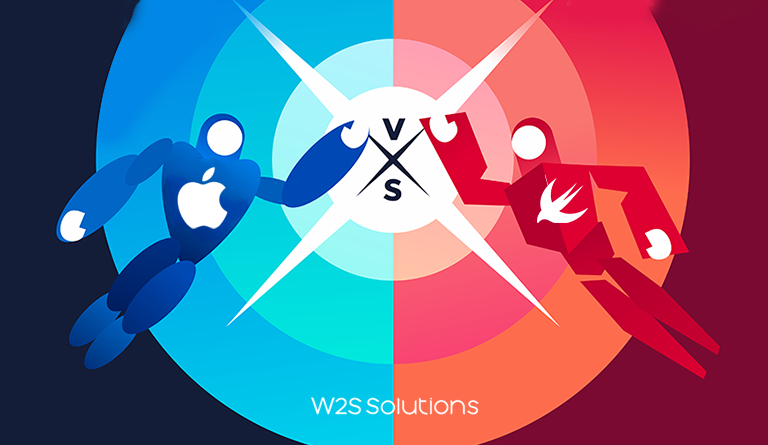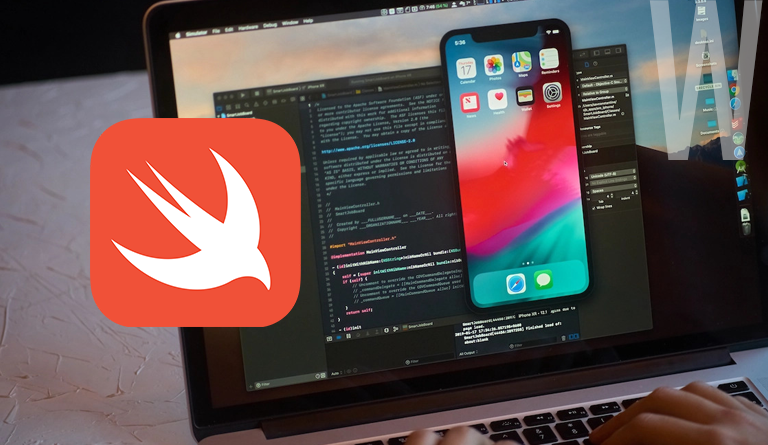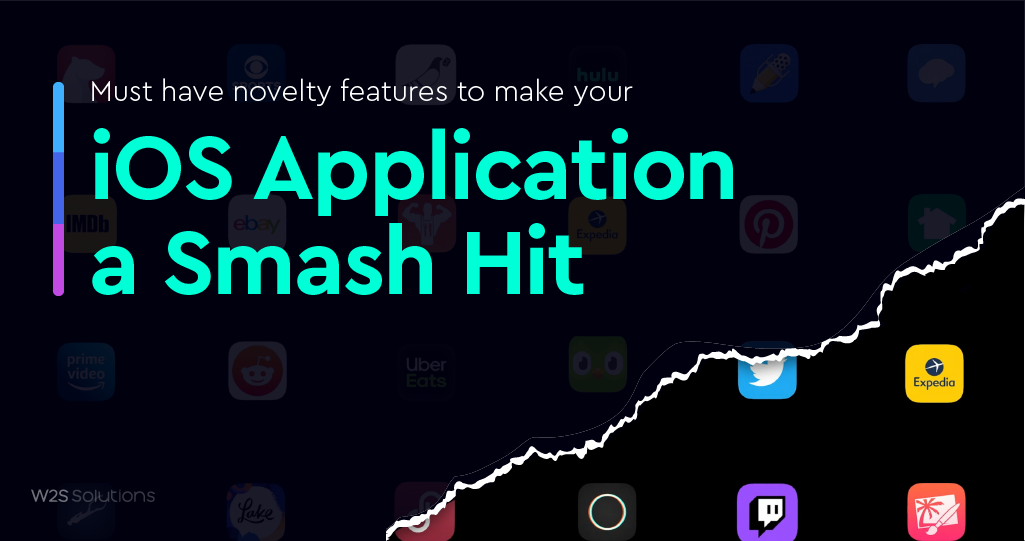TABLE OF CONTENT
When you aim to develop the perfect iOS app, one of the first things that you need to decide is the language that you will need for the project. In terms of native mobile app development for iOS, you basically get two choices: either use the good old Objective-C or go with the next-gen Swift.
Now, understanding the ideal programming language for iOS app development needs you to consider the features, differences, pros, and cons of both the options that you have on hand.
So, without further ado, let’s get right into the details of Swift vs. Objective-C.
The main features and characteristics of the languages:
Objective-C:
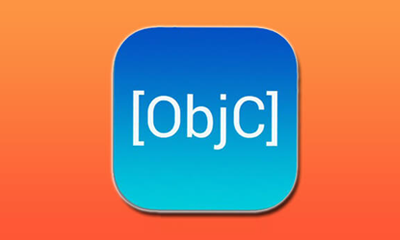
Way back in the 1980s, Brad Cox and Tom Love of the Stepstone Company came up with the programming language Objective-C, as the extension of C. It was released in the market in 1988, and the response it received was quite amazing. “Object-Oriented Programming: An Evolutionary Approach”: a book written by Brad Cox and Tom Love in the same year was instrumental in the success of this programming language.
Finally, during the late 1980s, NeXT Computer, Inc. acquired the license for Objective-C for developing the frameworks for ‘NeXTStep,’ which was again picked up by Apple. Thus, Objective-C came up to be the standard in terms of iOS app development for many years.
Basically, two programming languages were brought together to create Objective-C, namely, Smalltalk and C. This is what makes it a language with an extensive, complex syntax. Smalltalk gives it the object syntax, and the non-object syntax comes from C.
According to Apple, Objective-C comes with object-oriented capabilities along with the dynamic runtime.
Message passing and dynamic tapping are used by Objective-C. The code blocks of implementation and interface are also required in this case for dividing classes.
Read Also – A precise estimate of the cost to develop an iOS mobile app?
Swift:

Swift is younger than Objective-C, as Apple began developing it in 2010 and it was released in the market four years after that. A year after that Swift was made open source. Swift goes way past C and Smalltalk and rather embraces the features of modern programming languages. So, here you will find type inference, optional, generics, and other such higher-order functions.
This language is compatible with macOS, iOS, watchOS, tvOS. Moreover, the concepts of Swift are similar to Objective-C. It includes late binding, dynamic dispatch, extensible programming, etc. Additionally, it works fine with figuring out the bugs and also addresses Null pointers.
In the year 2015, Swift 2.0 was released to the market. In addition to Apple platforms, Swift is also compatible with Linux. Moreover, by 2023 the mobile market is expected to grow $165billion with Swift acting as the next generation iOS language.
Since this is a modernized language, it comes with a simplified syntax and modern concise concepts. It also comes with an interactive development environment.
The speed of app development with both the languages:
The features that a programming language comes with are crucial in ensuring that you get the speed of app development that you aim for. Swift is actually swifter than Objective-C when it comes to speed!
The use of higher-order functions and generics makes the codes much more reusable and cleaner. Type inference and options also make sure that the codes are safe as they are being transferred to the compilator from the programmer.
Moreover, the syntax is highly concise and you don’t have to make two code blocks for implementation and class interface. So, the programmers don’t need to write codes as lengthy in Swift as they have to in the case of Objective-C. In addition to that, there is a general consensus among the developers that this factor alone gives Swift an edge over Objective-C.
10 Major Differences between Objective-C and Swift:
|
Comparison table for Swift vs Objective C
| Metric | Swift | Objective C |
| Design | It was intended for the development of Apple’s operating systems | It’s been designed for object orientation, along with the messaging features. |
| Classes | Only class support is supported by Swift. | In Objective C, constraints are supported as well as classes. |
| License | It’s a project licensed under the Apache Open Source License. | It is licensed by the General Public Licence. |
| Polymorphism | It is possible to implement polymorphism by typecasting, but it does not have a direct existence. | At compile time, the polymorphism is evaluated in Objective C. |
| Type | Swift is static type | Objective C is dynamic type |
| Libraries | There are a lot of libraries in it. | It’s limited or there’s a shortage of libraries. |
| Boolean operators | Values are in lowercase true and false and the type is in title case Bool. | It is possible to write bool types using uppercase or lowercase letters with true or false, and yes or no as the values. You’ll be following any code conventions you see in your project, which are often a combination of BOOL, YES, and NO. |
The pros and cons of both the languages
There is no denying the fact that you can develop apps faster in Swift, but that’s not the be-all and end-all of the decision to choose a programming language for your iOS app. So, let’s take a look at the pros and cons of both languages.
Being a mobile app development company, we specialize in developing an app with both Swift as well as Objective-C.
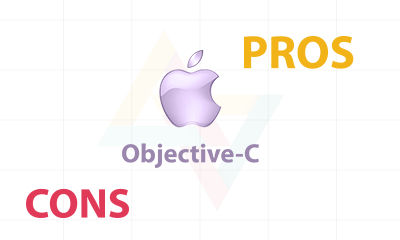
Advantages of Objective-C:
-
It’s been tried and tested for years:
Objective-C has literally been used for writing millions of codes from its beginning to this day. You will get an answer to almost every question and every doubt thanks to the third-party frameworks and the documentation that exists.
-
Dynamic Tapping:
It comes with a feature such as Dynamic Tapping where the coding environment is more flexible. Hence, developers can make the required changes whenever needed at any stage of development.
-
Ad-ons support:
Also, it supports effectively Binary frameworks. Moreover, it has been over 3 decades which makes Objective-C a stable one.
-
The compatibility with C++ and C:
Objective-C is actually a superset of the programming language C. Thus, it works pretty smoothly for both C++ and C codes.
-
The stability factor:
If an application is developed in Objective-C, you will not really have to spend your money on taking the application to a new language after a couple of months.
Disadvantages of Objective-C:
-
Not the easiest to learn:
It is significantly different from other common programming languages. The memory management of Objective-C is really complex. Thus, if a developer has an idea about Objective-C, he can learn and start working with Swift easily.
-
The dwindling number of supporters:
With the difficulty posed in learning Objective-C, the new-age developers are keener to learn Swift rather than Objective-C. On the other hand, the seasoned developers who know all about Objective-C, find it easy to learn Swift. So, there is a steady stream of migration of developers from Objective-C to Swift.
-
Reverse engineering tools:
The app that has been made with Objective-C is easier to hack into compared to a Swift app. Objective-C is renowned by now, and it has been here for years. So, the tools of reverse engineering are quite sharp, as well.
-
Challenging Syntax:
It comes with a complex syntax with problems like Block Syntax. Since it is of Dynamic nature, debugging becomes difficult.
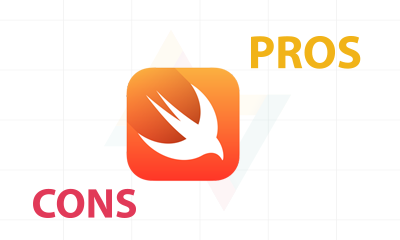
Advantages of Swift:
-
The safety factor:
The number of features on offer, right from type interference, optional, to generics, make sure that the Swift apps are not as prone to bugs or crashes as frequently as Objective-C. Added, this is more effective for writing code and error-free.
-
Memory Allocation:
Swift makes use of Automatic Reference Counting (ARC) which tracks the memory usage of apps. In Traditional languages, developers are responsible for tracking them manually by allocating memory.
-
Performance:
Swift tops the list with high performance and speed. This is since it uses both Object-oriented and enhanced memory management without garbage collection.
-
Apple is Swift-focused:
Apple develops the language and offers support to the community constantly. The developers are raving about the technicalities of Swift, which is an indication that this language deserves all the attention.
-
The developer’s team will love you!
survey reveals that Swift is one of the leading programming languages, while Objective-C is the most shied away from.
Disadvantages of Swift:
-
Changes and migrations:
The weakest link of Swift is the change and migration associated with it. However, it is already not as difficult as it was, but still, there is definitely chances of improvement after the introduction of ABI stability.
The constant changes in the language used to be a problem earlier. Developers had to shift to the new versions, which costs both money and time. The good thing is that, as time goes on, the subsequent versions are becoming better than ever before.
-
C++ Usage:
Undoubtedly, it cannot handle the direct usage of C++ libraries in it.
Read Also – Why iOS developers should pay attention to Flutter in 2020?
Which one to choose? Swift Vs Objective-C:
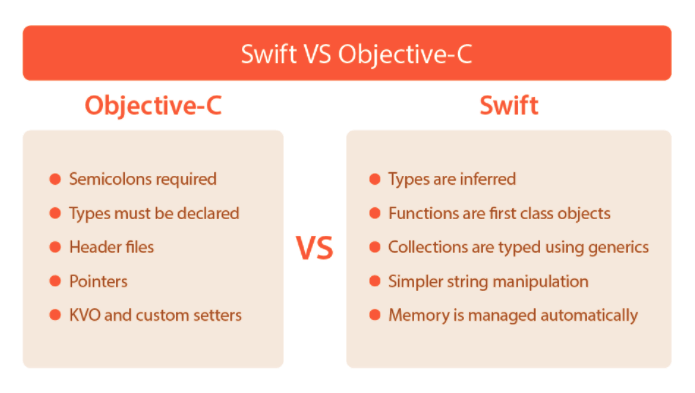
-
Performance
Apple has stated that Swift is 2.6 times faster than Objective-C. However, most of the reports claim that both have a slight difference in speed. Moreover, both languages use the same iOS and SDK along with the Low-Level Virtual Machine Compiler.
-
Maintenance
Maintenance remains to be complex with Objective-C compared to Swift. Since developers need to handle two separate files. On the other hand, with Swift, maintenance becomes hassle-free.
-
Security & Safety
Swift is a memory-safe and type-safe language which strengthens the security of the language. Along with this, it comes with a clear code that can be understood easily. Hence developers can easily spot the errors and rectify them when compared to Objective-C.
-
Coding Complexity
The complexity of the code remains to be a major factor. With Swift, coding becomes super easy with a limited number of lines. But in the case of Objective-C, it can result in crashing the application.
-
Developer Usage
Since Swift is at a growing age, people have started to learn and adopt this new language. Moreover, there are a few complexities such as maturity, less expertise, etc which makes developers move with Objective-C.
Summing up:
According to the ongoing discussions on this topic among the developers’ community, Swift is perfect for the latest, small apps. However, when it comes to large projects that already come with extensive Objective-C codebases, Swift might pose some difficulties at the onset. With that being said, Swift has become really advanced and many of its glitches are being progressively fixed, which makes it the ideal language for iOS app development.
Frequently Asked Questions
Get inspired!
Subscribe to our newsletter and get updates on how to navigate through disruption and make digital work for your business!
